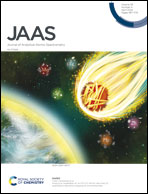Laser-induced breakdown spectroscopy combined with multivariate linear discriminant analysis for discriminating different growth phases of bacteria†
Abstract
Laser-induced breakdown spectroscopy was used to investigate the elemental structure and discrimination of bacteria growth phases. Two bacterial specimens including Gram-negative E. coli and Gram-positive S. aureus, are selected at four different times during the growth phases with recorded optical densities of 0.4, 0.8, 1.2 (exponential growth phase), and 2.2 (stationary growth phase). By comparing the intensities of C, Ca, Na, Mg, K, O, H, and CN bonds in the LIBS fingerprint spectrum in the growth phases, different patterns of elemental composition for both bacteria of interest, including their structure. Multivariate linear discriminant analysis is applied to the “principal lines” and the “mixture of principal lines and their ratios”. Analysis results depict different growth phases of bacteria are discriminated against each other during various classification accuracies ranging from 90% to 100%. Based on the results of the combination of LIBS and LDA, it is concluded that these bacteria can be classified during the growth process with high accuracy and precision.



 Please wait while we load your content...
Please wait while we load your content...